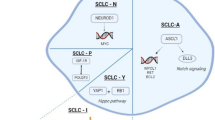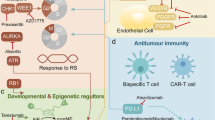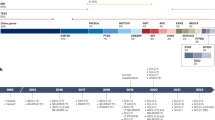Abstract
Small cell lung carcinoma (SCLC) accounts for approximately 15% of all lung cancer cases. Despite a frequently good response to first-line treatment with chemotherapy and/or radiotherapy, early relapse occurs in the majority of patients and 5-year survival is only about 5%. Therefore, there is a need to develop novel treatments to improve the outcome of patients with SCLC. To fulfil this need, it is critical to gain further understanding on the molecular basis of SCLC and specifically to identify novel therapeutic targets. Clinical trials with molecularly targeted agents have been performed with little success in the past, but recently many promising oncogenic pathways have been discovered and novel targeted therapies are under evaluation. In this review, we summarise the most relevant genetic and signalling pathway alterations reported to date in SCLC and discuss the potential therapeutic implications of such events.
Similar content being viewed by others
References
Cooper S, Spiro SG (2006) Small cell lung cancer: treatment review. Respirology 1:241–248.
Govindan R, Page N, Morgensztern D et al (2006) Changing epidemiology of small-cell lung cancer in the United States over the last 30 years: analysis of the surveillance, epidemiologic, and end results database. J Clin Oncol 24:4539–4544
Cheng S, Evans WK, Stys-Norman D, Shepherd FA (2007) Chemotherapy for relapsed small cell lung cancer: a systematic review and practice guideline. J Thorac Oncol 2:348–354
Spira A, Ettinger DS (2004) Multidsciplinary management of lung cancer. N Engl J Med 350:379–392
Miura I, Graziano SL, Cheng JQ et al (1992) Chromosome alterations in human small cell lung cancer: frequent involvement of 5q. Cancer Res. 52:1322–1328
Sozzi G, Bertoglio MG, Borrello MG et al (1987) Chromosomal abnormalities in a primary small cell lung cancer. Cancer Genet Cytogenet 27:45–50
Testa JR, Graziano SL (1993) Molecular implications of recurrent cytogenetic alterations in human small cell lung cancer. Cancer Detect Prev 17:267–277
Testa JR, Liu Z, Feder M et al (1997) Advances in the analysis of chromosome alterations in human lung carcinomas. Cancer Genet Cytogenet 95:20–32
Naylor SL, Johnson BE, Minna JD, Sakaguchi AY (1987) Loss of heterozygosity of chromosome 3p markers in small-cell lung cancer. Nature 329:451–454
Levin NA, Brzoska PM, Warnock ML et al (1995) Identification of novel regions of altered DNA copy number in small cell lung tumors. Genes Chromosomes Cancer 13:175–185
Balsara BR, Testa JR (2002) Chromosomal imbalances in human lung cancer. Oncogene 21:6877–6883
Ried T, Petersen I, Holtgreve-Grez H et al (1994) Mapping of multiple DNA gains and losses in primary small cell lung carcinomas by comparative genomic hybridization. Cancer Res 54:1801–1806
Brauch H, Johnson B, Hovis J et al (1987) Molecular analysis of the short arm of chromosome 3 in small-cell and non-small-cell carcinoma of the lung. N Engl J Med 317:1109–1113
Kok K, Osinga J, Carritt B et al (1987) Deletion of a DNA sequence at the chromosomal region 3p21 in all major types of lung cancer. Nature 330:578–581
Kim YH, Girard L, Giacomini CP et al (2006) Combined microarray analysis of small cell lung cancer reveals altered apoptotic balance and distinct expression signatures of MYC family gene amplification. Oncogene 25:130–138
Wistuba II, Gazdar AF, Minna JD (2001) Molecular genetics of small cell lung carcinoma. Semin Oncol 28[Suppl 4]:3–13
Yokomizo A, Tindall DJ, Drabkin H et al (1998) PTEN/MMAC1 mutations identified in small cell, but not in non-small cell lung cancers. Oncogene 17:475–479
Blackhall FH, Pintilie M, Michael M et al (2003) Expression and prognostic significance of kit, protein kinase B, and mitogen-activated protein kinase in patients with small cell lung cancer. Clin Cancer Res 9:2241–2247
Kraus AC, Ferber I, Bachmann SO et al (2002) In vitro chemo-and radio-resistance in small cell lung cancer correlates with cell adhesion and constitutive activation of AKT and MAP kinase pathways. Oncogene 21:8683–8695
Mirski SE, Evans CD, Almquist KC et al (1993) Altered topoisomerase II alpha in a drug-resistant small cell lung cancer cell line selected in VP-16. Cancer Res 53:4866–4873
Cole SP, Chanda ER, Dicke FP et al (1991) Non-P-glycoprotein-mediated multidrug resistance in a small cell lung cancer cell line: evidence for decreased susceptibility to drug-induced DNA damage and reduced levels of topoisomerase II. Cancer Res 51:3345–3352
El-Khoury V, Breuzard G, Fourre N, Dufer J (2007) The histone deacetylase inhibitor trichostatin A downregulates human MDR1 (ABCB1) gene expression by a transcription-dependent mechanism in a drug-resistant small cell lung carcinoma cell line model. Br J Cancer 97:562–573
Kubo A, Yoshikawa A, Hirashima T et al (1996) Point mutations of the topoisomerase IIalpha gene in patients with small cell lung cancer treated with etoposide. Cancer Res 56:1232–1236
Sugita M, Geraci M, Gao B et al (2002) Combined use of oligonucleotide and tissue microarrays identifies cancer/testis antigens as biomarkers in lung carcinoma. Cancer Res 62:3971–3979
Garber ME, Troyanskaya OG, Schluens K et al (2001) Diversity of gene expression in adenocarcinoma of the lung. Proc Natl Acad Sci USA 98:13784–13789
Pedersen N, Mortensen S, Sorensen SB et al (2003) Transcriptional gene expression profiling of small cell lung cancer cells. Cancer Res 63:1943–1953
Bhattacharjee A, Richards WG, Staunton J et al (2001) Classification of human lung carcinomas by mRNA expression profiling reveals distinct adenocarcinoma subclasses. Proc Natl Acad Sci USA 98:13790–13795
Jones MH, Virtanen C, Honjoh D et al (2004) Two prognostically significant subtypes of high-grade lung neuroendocrine tumours independent of small-cell and large-cell neuroendocrine carcinomas identified by gene expression profiles. Lancet 363:775–781
Virtanen C, Ishikawa Y, Honjoh D et al (2002) Integrated classification of lung tumors and cell lines by expression profiling. Proc Natl Acad Sci USA 99:12357–12362
Westerman BA, Neijenhuis S, Poutsma A et al (2002) Quantitative reverse transcription-polymerase chain reaction measurement of HASH1 (ASCL1), a marker for small cell lung carcinomas with neuroendocrine features. Clin Cancer Res 8:1082–1086
De Smaele E, Fragomeli C, Ferretti E et al (2008) An integrated approach identifies Nhlh1 and Insm1 as Sonic Hedgehog-regulated genes in developing cerebellum and medulloblastoma. Neoplasia 10:89–98
Somasundaram K, Reddy SP, Vinnakota K et al (2005) Upregulation of ASCL1 and inhibition of Notch signaling pathway characterize progressive astrocytoma. Oncogene 24:7073–7083
Pedersen N, Pedersen MW, Lan MS et al (2006) The insulinoma-associated 1: a novel promoter for targeted cancer gene therapy for small-cell lung cancer. Cancer Gene Ther 13:375–384
Esquela-Kerscher A, Slack FJ (2006) OncomirsmicroRNAs with a role in cancer. Nat Rev Cancer 6:259–269
Yanaihara N, Caplen N, Bowman E et al (2006) Unique microRNA molecular profiles in lung cancer diagnosis and prognosis. Cancer Cell 9:189–198
Yu SL, Chen HY, Chang GC et al (2008) MicroRNA signature predicts survival and relapse in lung cancer. Cancer Cell 13:48–57
Hayashita Y, Osada H, Tatematsu Y et al (2005) A polycistronic microRNA cluster, miR-17-92, is overexpressed in human lung cancers and enhances cell proliferation. Cancer Res 65:9628–9632
Angeloni D, ter Elst A, Wei MH et al (2006) Analysis of a new homozygous deletion in the tumor suppressor region at 3p12.3 reveals two novel intronic noncoding RNA genes. Genes Chromosomes Cancer 45:676–691
ter Elst A, Hiemstra BE, van der Vlies P et al (2006) Functional analysis of lung tumor suppressor activity at 3p21.3. Genes Chromosomes Cancer 45:1077–1093
Quinn KA, Treston AM, Unsworth EJ et al (1996) Insulin-like growth factor expression in human cancer cell lines. J Biol Chem 271:11477–11483
Nakanishi Y, Mulshine JL, Kasprzyk PG et al (1988) Insulin-like growth factor-I can mediate autocrine proliferation of human small cell lung cancer cell lines in vitro. J Clin Invest 82:354–359
Reeve JG, Morgan J, Schwander J, Bleehen NM (1993) Role for membrane and secreted insulin-like growth factor-binding protein-2 in the regulation of insulin-like growth factor action in lung tumors. Cancer Res 53:4680–4685
Macaulay VM, Everard MJ, Teale JD et al (1990) Autocrine function for insulin-like growth factor I in human small cell lung cancer cell lines and fresh tumor cells. Cancer Res 50:2511–2517
Warshamana-Greene GS, Litz J, Buchdunger E et al (2005) The insulin-like growth factor-I receptor kinase inhibitor, NVP-ADW742, sensitizes small cell lung cancer cell lines to the effects of chemotherapy. Clin Cancer Res 11:1563–1571
Warshamana-Greene GS, Litz J, Buchdunger E et al (2004) The insulin-like growth factor-I (IGF-I) receptor kinase inhibitor NVP-ADW742, in combination with STI571, delineates a spectrum of dependence of small cell lung cancer on IGF-I and stem cell factor signaling. Mol Cancer Ther 3:527–535
Hibi K, Takahashi T, Sekido Y et al (1991) Coexpression of the stem cell factor and the c-kit genes in small-cell lung cancer. Oncogene 6:2291–2296
Rygaard K, Nakamura T, Spang-Thomsen M (1993) Expression of the proto-oncogenes c-met and c-kit and their ligands, hepatocyte growth factor/scatter factor and stem cell factor, in SCLC cell lines and xenografts. Br J Cancer 67:37–46
Sekido Y, Obata Y, Ueda R et al (1991) Preferential expression of c-kit protooncogene transcripts in small cell lung cancer. Cancer Res 51:2416–2419
Jonkers J, Berns A (2004) Oncogene addiction: sometimes a temporary slavery. Cancer Cell 6:535–538
Takigawa N, Segawa Y, Fujimoto N et al (1998) Elevated vascular endothelial growth factor levels in sera of patients with lung cancer. Anticancer Res 18:1251–1254
Salven P, Ruotsalainen T, Mattson K, Joensuu H (1998) High pre-treatment serum level of vascular endothelial growth factor (VEGF) is associated with poor outcome in small-cell lung cancer. Int J Cancer 79:144–146
Fontanini G, Faviana P, Lucchi M et al (2002) A high vascular count and overexpression of vascular endothelial growth factor are associated with unfavourable prognosis in operated small cell lung carcinoma. Br J Cancer 86:558–563
Ruotsalainen T, Joensuu H, Mattson K, Salven P (2002) High pretreatment serum concentration of basic fibroblast growth factor is a predictor of poor prognosis in small cell lung cancer. Cancer Epidemiol Biomarkers Prev 11:1492–1495
Sandler A, Gray R, Perry MC et al (2006) Paclitaxel-carboplatin alone or with bevacizumab for non-small-cell lung cancer. N Engl J Med 355:2542–2550
Litz J, Sakuntala Warshamana-Greene G, Sulanke G et al (2004) The multi-targeted kinase inhibitor SU5416 inhibits small cell lung cancer growth and angiogenesis, in part by blocking Kit-mediated VEGF expression. Lung Cancer 46:283–291
Pujol JL, Breton JL, Gervais R et al (2007) Phase III double-blind, placebo-controlled study of thalidomide in extensive-disease small-cell lung cancer after response to chemotherapy: an intergroup study FNCLCC cleo04 IFCT 00-01. J Clin Oncol 25:3945–3951
Arnold AM, Seymour L, Smylie M et al (2007) Phase II study of vandetanib or placebo in small-cell lung cancer patients after complete or partial response to induction chemotherapy with or without radiation therapy: National Cancer Institute of Canada Clinical Trials Group Study BR.20. J Clin Oncol 25:4278–4284
Okamoto I, Araki J, Suto R et al (2006) EGFR mutation in gefitinib-responsive small-cell lung cancer. Ann Oncol 17:1028–1029
Zakowski MF, Ladanyi M, Kris MG (2006) EGFR mutations in small-cell lung cancers in patients who have never smoked. N Engl J Med 355:213–215
Moore AM, Einhorn LH, Estes D et al (2006) Gefitinib in patients with chemo-sensitive and chemo-refractory relapsed small cell cancers: a Hoosier Oncology Group phase II trial. Lung Cancer 52:93–97
Ma PC, Maulik G, Christensen J, Salgia R (2003) c-Met: structure, functions and potential for therapeutic inhibition. Cancer Metastasis Rev 22:309–325
Maulik G, Kijima T, Ma PC et al (2002) Modulation of the c-Met/hepatocyte growth factor pathway in small cell lung cancer. Clin Cancer Res 8:620–627
Ma PC, Kijima T, Maulik G et al (2003) c-MET mutational analysis in small cell lung cancer: novel juxtamembrane domain mutations regulating cytoskeletal functions. Cancer Res 63:6272–6281
Ma PC, Jagadeeswaran R, Jagadeesh S et al (2005) Functional expression and mutations of c-Met and its therapeutic inhibition with SU11274 and small interfering RNA in non-small cell lung cancer. Cancer Res 65:1479–1488
Ma PC, Schaefer E, Christensen JG, Salgia R (2005) A selective small molecule c-MET Inhibitor, PHA665752, cooperates with rapamycin. Clin Cancer Res 11:2312–2319
Puri N, Khramtsov A, Ahmed S et al (2007) A selective small molecule inhibitor of c-Met, PHA665752, inhibits tumorigenicity and angiogenesis in mouse lung cancer xenografts. Cancer Res 67:3529–3534
Shaw RJ, Cantley LC (2006) Ras, PI(3)K and mTOR signalling controls tumour cell growth. Nature 441:424–430
Albanell J, Dalmases A, Rovira A, Rojo F (2007) mTOR signalling in human cancer. Clin Transl Oncol 9:484–493
Moore SM, Rintoul RC, Walker TR et al (1998) The presence of a constitutively active phosphoinositide 3-kinase in small cell lung cancer cells mediates anchorage-independent proliferation via a protein kinase B and p70s6k-dependent pathway. Cancer Res 58:5239–5247
Razzini G, Berrie CP, Vignati S et al (2000) Novel functional PI 3-kinase antagonists inhibit cell growth and tumorigenicity in human cancer cell lines. FASEB J 14:1179–1187
Wu C, Wangpaichitr M, Feun L et al (2005) Overcoming cisplatin resistance by mTOR inhibitor in lung cancer. Mol Cancer 4:25
Sartorius UA, Krammer PH (2002) Upregulation of Bcl-2 is involved in the mediation of chemotherapy resistance in human small cell lung cancer cell lines. Int J Cancer 97:584–592
Ikegaki N, Katsumata M, Minna J, Tsujimoto Y (1994) Expression of bcl-2 in small cell lung carcinoma cells. Cancer Res 54:6–8
Jiang SX, Sato Y, Kuwao S, Kameya T (1995) Expression of bcl-2 oncogene protein is prevalent in small cell lung carcinomas. J Pathol 177:135–138
Ziegler A, Luedke GH, Fabbro D et al (1997) Induction of apoptosis in small-cell lung cancer cells by an antisense oligodeoxynucleotide targeting the Bcl-2 coding sequence. J Natl Cancer Inst 89:1027–1036
Zangemeister-Wittke U, Schenker T, Luedke GH, Stahel RA (1998) Synergistic cytotoxicity of bcl-2 antisense oligodeoxynucleotides and etoposide, doxorubicin and cisplatin on small-cell lung cancer cell lines. Br J Cancer 78:1035–1042
Rudin CM, Kozloff M, Hoffman PC et al (2004) Phase I study of G3139, a bcl-2 antisense oligonucleotide, combined with carboplatin and etoposide in patients with small-cell lung cancer. J Clin Oncol 22:1110–1117
Rudin CM, Salgia R, Wang X et al (2008) Randomized phase II Study of carboplatin and etoposide with or without the bcl-2 antisense oligonucleotide oblimersen for extensive-stage small-cell lung cancer: CALGB 30103. J Clin Oncol 26:870–876
Corjay MH, Dobrzanski DJ, Way JM et al (1991) Two distinct bombesin receptor subtypes are expressed and functional in human lung carcinoma cells. J Biol Chem 266:18771–18779
Cuttitta F, Carney DN, Mulshine J et al (1985) Bombesin-like peptides can function as autocrine growth factors in human small-cell lung cancer. Nature 316:823–826
Martinez A, Zudaire E, Julian M et al (2005) Gastrin-releasing peptide (GRP) induces angiogenesis and the specific GRP blocker 77427 inhibits tumor growth in vitro and in vivo. Oncogene 24:4106–4113
Mahmoud S, Staley J, Taylor J et al (1991) [Psi 13,14] bombesin analogues inhibit growth of small cell lung cancer in vitro and in vivo. Cancer Res 51:1798–1802
Kelley MJ, Linnoila RI, Avis IL et al (1997) Antitumor activity of a monoclonal antibody directed against gastrin-releasing peptide in patients with small cell lung cancer. Chest 112:256–261
Arriola E, Rodriguez-Pinilla SM, Lambros MB et al (2007) Topoisomerase II alpha amplification may predict benefit from adjuvant anthracyclines in HER2 positive early breast cancer. Breast Cancer Res Treat 106:181–189
Dingemans AM, Witlox MA, Stallaert RA et al (1999) Expression of DNA topoisomerase IIalpha and topoisomerase IIbeta genes predicts survival and response to chemotherapy in patients with small cell lung cancer. Clin Cancer Res 5:2048–2058
Ohe Y, Negoro S, Matsui K et al (2005) Phase I–II study of amrubicin and cisplatin in previously untreated patients with extensive-stage small-cell lung cancer. Ann Oncol 16:430–436
Onoda S, Masuda N, Seto T et al (2006) Phase II trial of amrubicin for treatment of refractory or relapsed small-cell lung cancer: Thoracic Oncology Research Group Study 0301. J Clin Oncol 24:5448–5453
Hanada M, Mizuno S, Fukushima A et al (1998) A new antitumor agent amrubicin induces cell growth inhibition by stabilizing topoisomerase II-DNA complex. Jpn J Cancer Res 89:1229–1238
Lanier LL, Testi R, Bindl J, Phillips JH (1989) Identity of Leu-19 (CD56) leukocyte differentiation antigen and neural cell adhesion molecule. J Exp Med 169:2233–2238
Doria MI Jr, Montag AG, Franklin WA (1988) Immunophenotype of small cell lung carcinoma. Expression of NKH-1 and transferrin receptor and absence of most myeloid antigens. Cancer 62:1939–1945
Onuki N, Wistuba II, Travis WD et al (1999) Genetic changes in the spectrum of neuroendocrine lung tumors. Cancer 85:600–607
Nikitina EY, Chada S, Muro-Cacho C et al (2002) An effective immunization and cancer treatment with activated dendritic cells transduced with full-length wild-type p53. Gene Ther 9:345–352
Antonia SJ, Mirza N, Fricke I et al (2006) Combination of p53 cancer vaccine with chemotherapy in patients with extensive stage small cell lung cancer. Clin Cancer Res 12:878–887
Cagle PT, el-Naggar AK, Xu HJ et al (1997) Differential retinoblastoma protein expression in neuroendocrine tumors of the lung. Potential diagnostic implications. Am J Pathol 150:393–400
Gutova M, Najbauer J, Gevorgyan A et al (2007) Identification of uPAR-positive chemoresistant cells in small cell lung cancer. PLoS ONE 2:e243
Dammann R, Li C, Yoon JH et al (2000) Epigenetic inactivation of a RAS association domain family protein from the lung tumour suppressor locus 3p21.3. Nat Genet 25:315–319
Sozzi G, Veronese ML, Negrini M et al (1996) The FHIT gene 3p14.2 is abnormal in lung cancer. Cell 85:17–26
Levin NA, Brzoska P, Gupta N et al (1994) Identification of frequent novel genetic alterations in small cell lung carcinoma. Cancer Res 54:5086–5091
Brennan J, O’Connor T, Makuch RW et al (1991) myc family DNA amplification in 107 tumors and tumor cell lines from patients with small cell lung cancer treated with different combination chemotherapy regimens. Cancer Res 51:1708–1712
Wurster-Hill DH, Cannizzaro LA, Pettengill OS et al (1984) Cytogenetics of small cell carcinoma of the lung. Cancer Genet Cytogenet 13:303–330
Author information
Authors and Affiliations
Corresponding author
Rights and permissions
About this article
Cite this article
Arriola, E., Cañadas, I., Arumí, M. et al. Genetic changes in small cell lung carcinoma. Clin Transl Oncol 10, 189–197 (2008). https://doi.org/10.1007/s12094-008-0181-1
Received:
Accepted:
Published:
Issue Date:
DOI: https://doi.org/10.1007/s12094-008-0181-1




